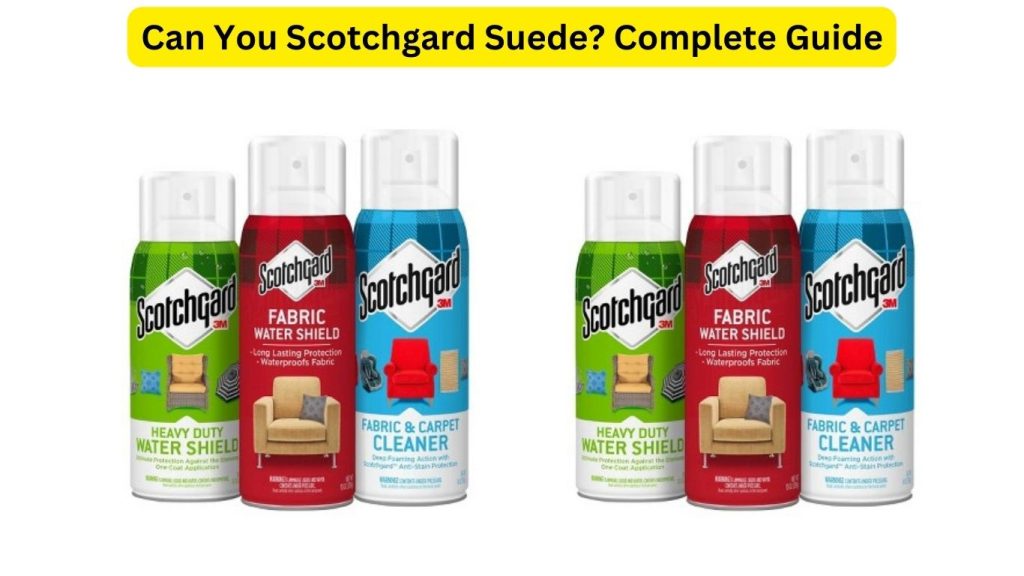Scotchgard, a renowned fabric protector, is commonly utilized to safeguard materials against stains and spills. While originally designed for textiles, its application to suede requires a specific approach due to suede’s unique texture and sensitivity.

This guide presents a comprehensive overview of the process involved in effectively Scotchgard-ing suede. From preparation and application to potential risks and aftercare, understanding the intricacies of treating suede with Scotchgard ensures optimal results in preserving its appearance and prolonging its lifespan.
By following this guide, you’ll gain the insights needed to successfully protect your suede items and enjoy them for years to come.
Table of Contents
Can You Use Scotchgard On Sude?
Yes, Scotchgard can be used on the suede to provide a protective barrier against stains and spills. However, applying Scotchgard to suede requires special attention due to the suede’s delicate nature.
It’s important to carefully follow the manufacturer’s instructions and test a small, inconspicuous area before applying it to the entire suede item.
While Scotchgard can effectively repel liquids and prevent staining, there is a possibility of slight changes in texture or color. Regular reapplication and proper care are recommended to maintain its effectiveness over time.
Does Scotchgard Work On Suede?
Yes, Scotchgard can work on the suede to provide a level of protection against stains and spills. However, its effectiveness on suede can vary depending on factors such as the type of suede, application technique, and the specific nature of the stains.
It’s important to note that while Scotchgard can offer some level of protection, it might not completely prevent all stains on suede.
Regular maintenance, proper application, and cautious testing on a small area are recommended to achieve the best results and maintain the appearance of your suede items.
Is Scotchgard Safe For Suede?
Yes, Scotchgard is generally safe for suede when applied correctly and following the manufacturer’s instructions. However, it’s important to exercise caution and perform a patch test in an inconspicuous area before applying it to the entire suede item.
While Scotchgard can provide protection against stains and spills, there is a possibility that it may slightly alter the texture or color of the suede. Proper application and allowing sufficient drying time are essential to minimize any potential negative effects.
Regular maintenance and reapplication, as well as considering the specific type of suede, will contribute to the overall safety and effectiveness of using Scotchgard on suede.
How To Scotchgard Suede: Step-By-Step Guide
Scotchgard is a brand that offers various products for protecting fabrics and materials from stains, including suede. Here’s a step-by-step guide on how to Scotchgard suede:
Materials Needed:
- Scotchgard suede protector spray
- A suede brush or clean cloth
- Soft bristle brush
- Clean, dry cloth
- Newspaper or plastic to protect surrounding areas
Step-By-Step Guide:
- Preparation:
- Start by working in a well-ventilated area to ensure proper air circulation.
- Lay down newspaper or plastic to protect the surrounding surfaces from overspray.
- Clean the Suede:
- Before applying any protector, make sure the suede is clean and free from dust, dirt, and stains.
- Use a suede brush or a clean cloth to gently brush off any loose dirt and restore the suede’s texture.
- Testing:
- Before applying the protector to the entire item, it’s a good idea to test it on a small, inconspicuous area of the suede to ensure there are no adverse effects. Allow it to dry completely before assessing the results.
- Application:
- Hold the Scotchgard suede protector spray about 6 to 8 inches away from the suede surface.
- Apply an even, light coating of the protector spray. Be careful not to oversaturate the suede; a light mist is sufficient.
- Work in sections if the item is large. Allow the protector to dry for about 1-2 hours, or as directed on the product label.
- Second Coat (Optional):
- Depending on the level of protection you desire, you can apply a second coat of the protector after the first one has dried.
- Allow the second coat to dry thoroughly.
- Brushing:
- After the suede protector has dried completely, use a soft bristle brush to gently brush the suede in the natural direction of the fibers.
- This step helps to restore the suede’s texture and remove any stiffness that might have resulted from the protector.
- Final Drying:
- Let the item sit for a few hours or overnight in a well-ventilated area to ensure that the protector is fully dry.
- Final Touches:
- Once the suede protector is dry, use a clean, dry cloth to lightly buff the suede and remove any excess residue.
Remember to always follow the instructions provided on the Scotchgard product label for the best results.
Additionally, keep in mind that no protective product can make suede completely waterproof or stain-proof, but it can provide a level of protection against spills and stains.
Regular maintenance and reapplication are important to maintain the effectiveness of the protection.
Final Words
Scotchgard can indeed be applied to suede with proper care and technique. Through this guide, we’ve delved into the essential steps: preparing the suede, applying the Scotchgard evenly, and allowing it to dry thoroughly.
While Scotchgard offers valuable protection against stains and spills, it’s important to note that it may slightly alter the suede’s texture or color. Regular maintenance and reapplication are recommended for continued effectiveness.
Remember to test a small, inconspicuous area before full application and always follow the manufacturer’s instructions. By responsibly using Scotchgard on suede, you can extend the life and beauty of your cherished suede items.
